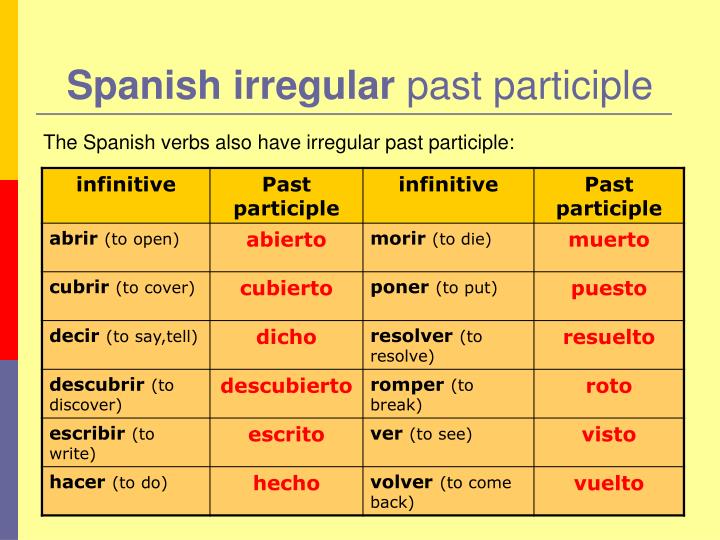
The truth is that you won't master English without studying them. Note in this video on a verb chart, the l / ella / usted form should not have an accent on i and should read io since vio and dio do not have.
#DO SPANISH IRREGULAR PAST TENSE VERBS HAVE ACCENTS HOW TO#
There's no real trick to learning how to use irregular verbs. So, if you're learning or teaching English, you must embrace them. Somewhat counter-intuitively, the most common verbs in English are irregular. Here is a Venn diagram that explains how verbs are classified: Similarly, the terms "regular verb" and "weak verb" are not synonyms. The terms "irregular verb" and "strong verb" are not synonyms (i.e., they do not mean the same). Infographic Explaining Strong, Weak, Regular, and Irregular Verbs Here are some examples of strong and weak irregular verbs: You simply use a past tense and make it a question by making your voice go up at the end or changing the word order you make it negative by adding no. Irregular Verbs Can Be Strong or Weak VerbsĪn irregular verb can be either a weak verb (when its past forms end "-d" or "-t") or a strong verb. Note that Spanish has no direct translation of did or didn’t in questions or negative sentences. Some irregular verbs do not change their forms for the simple past tense and the past participle: The second form (e.g., learnt, dreamt) is more common in British English. The following verbs can be regular or irregular: It can be used on its own or with a and an infinitive verb to indicate that the subject is going to do. Ir is one of the most common verbs in Spanish. Read on to learn more Ir Conjugation Charts. Here is a fuller list of the most common irregular verbs in English: Use a Spanish conjugation chart to help you In this article, we’ll talk about the Spanish verb ir and give you the ir conjugation charts you need.

With an irregular verb, the past form and past participle are often different (but not always). Ironically, the most commonly used verbs in English are all irregular: These verbs require a spell change when they are used ONLY IN THE YO form.Click on the green letters to spell the past tense and then the past participle of the irregular verb shown. We’ve reached our final section about irregular verbs in the Preterit Tense! Our last section is all about verbs that end in either -car, -gar, or -zar.

We are learning these two together because as you will see, their conjugations are almost identical. Our two final irregular verbs in the Preterit Tense are VER and DAR. Let’s take a look at their conjugation below: Fui – I went/I wasįuiste – You (informal) went/You (informal) wereįue – He went/He was She went/She was You (formal) went/You wereįueron – They went/They were You all went/You all were But, how will you know the difference if they look and sound exactly the same you ask? We will know which verb is being used based on context. However, great news! These two verbs are conjugated the exact same way in the Preterit Tense. There are two verbs in the Preterit Tense that are extra irregular – SER (to be) and IR (to go). “ J Stem Verbs” – notice that these verbs have changed to having an “ j” in the stem. “ U Stem Verbs” – notice that these verbs have changed to having an “ u” in the stem. “ I Stem Verbs” – notice that these verbs have changed to having an “ i” in the stem. The following irregular Preterit verbs use the irregular Preterit endings from the chart above.

NOTE: We will see a few different endings in section 2. All of these endings are used with the verbs in this first section of irregular Preterit verbs and none of them carry accents. Repetition and memorization are your tools for success with these verbs!įirst, let’s take a look at the common IRREGULAR PRETERIT TENSE ENDINGS. Now that we have a good grasp on Regular Verbs in the Preterit Tense, it’s time to venture into the world of irregular verbs! Because some of the most common Spanish verbs actually have irregular conjugations in the Preterit Tense, it’s important that we become familiar with their rules and changes.


 0 kommentar(er)
0 kommentar(er)
